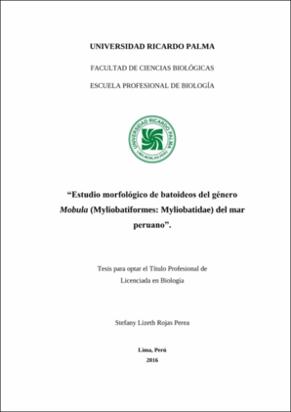Mostrar el registro sencillo del ítem
Estudio morfológico de batoideos del género Mobula (Myliobatiformes: Myliobatidae) del mar peruano
| dc.contributor.advisor | Ayon Dejo, Patricia Mercedes | |
| dc.contributor.author | Rojas Perea, Stefany Liseth | |
| dc.date.accessioned | 2017-05-31T17:09:10Z | |
| dc.date.available | 2017-05-31T17:09:10Z | |
| dc.date.issued | 2016 | |
| dc.identifier.uri | https://hdl.handle.net/20.500.14138/916 | |
| dc.description.abstract | Se verificó la ocurrencia de mobulas en el terminal pesquero de Zorritos desde enero a diciembre del año 2015, haciendo énfasis en datos morfométricos correspondientes al ancho (AD) y largo (LD) del disco corporal, peso, sexo, madurez sexual en los individuos machos (tamaño de clásper) y arte de pesca utilizados. 4 especies de mobulas fueron identificadas Mobula. japanica, M. munkiana, M.thurstoni y M. tarapacana. De 355 individuos muestreados la especie más abundante y de mayor tamaño fue M. japanica (83.7%, AD: 1719.8 ± 253.6 mm), seguida por M. munkiana (14.9%, AD: 1104.9 ± 133.5mm). Se dieron 4 únicos reportes de M. thurstoni (1.1%, AD: 1047.5± 190.5mm), y un reporte de M. tarapacana (0.3%, AD: 1047.5 mm). La especie que presentó mayor cantidad de juveniles fue M. japanica (95%). Todos los individuos de M. thurstoni y el único ejemplar de M. tarapacana también se encontraron por debajo de la Longitud mínima de madurez sexual (Lm). Adicionalmente se acompañó en 24 viajes a bordo de embarcaciones pesqueras frente a las costas de Puerto Pizarro, La Cruz, Zorritos y Acapulco. Se logró georeferenciar 26 puntos de avistamiento de mobulas en altamar. El arte de pesca predominante utilizado para la captura de estas especies fue el de cerco y cortina a flote. Las características oceanográficas, geográficas y biológicas que presenta el mar del norte de Perú hacen posible la presencia de las diferentes especies de mobulas.Mobula’s occurrence were identified in the fishing terminal Zorritos from January to December 2015, emphasizing morphometric data like width disc (AD) and long disc (LD), weight, sex, sexual maturity in male individuals (size clasper) and fishing gear used. 4 species of mobulas were identified Mobula japanica, M. munkiana, M. thurstoni and M. tarapacana. 355 individuals were sampled. The most abundant and larger species was M. japanica (83.7% AD: 1719.8 ± 253.6 mm), followed by M. munkiana (14.9% AD: 1104.9 ± 133.5mm), 4 unique reports were given by M. thurstoni (1.1% AD: 1047.5 ± 190.5mm), and an unique report of M. tarapacana (0.3% AD: 1047.5 mm). The species that presented the highest number of juveniles was M. japanica (95%). All individuals of M. thurstoni and the only copy of M. tarapacana also found below the minimum length of sexual maturity (Lm). Additionally, 24 boat trips aboard fishing vessels were completed off the coast of Puerto Pizarro, La Cruz, Zorritos and Acapulco. 26 georeferencing points were reported of mobulas sighting at sea. The predominant fishing gear for catching these species were purse sein and longline. Oceanographic, geographic and biological characteristics of the northern Peruvian sea allow for the presence of different species of mobulas. | es_ES |
| dc.description.sponsorship | Submitted by Wong Rafael (rafel_wl@hotmail.com) on 2017-05-31T17:09:10Z No. of bitstreams: 1 Rojas_sl.pdf: 759070 bytes, checksum: 56994cb33708510b32c1a8c5c3274d44 (MD5) | es_ES |
| dc.description.sponsorship | Made available in DSpace on 2017-05-31T17:09:10Z (GMT). No. of bitstreams: 1 Rojas_sl.pdf: 759070 bytes, checksum: 56994cb33708510b32c1a8c5c3274d44 (MD5) Previous issue date: 2016 | es_ES |
| dc.description.uri | Tesis | es_ES |
| dc.format | application/pdf | |
| dc.language.iso | spa | |
| dc.publisher | Universidad Ricardo Palma - URP | es_ES |
| dc.rights | info:eu-repo/semantics/openAccess | |
| dc.rights.uri | https://creativecommons.org/licenses/by-nc-nd/4.0/ | |
| dc.source | Repositorio Institucional - URP | es_ES |
| dc.subject | mobula | es_ES |
| dc.subject | morfometría | es_ES |
| dc.subject | pesca | es_ES |
| dc.subject | mar peruano | es_ES |
| dc.subject | morphometry | es_ES |
| dc.subject | fishing | es_ES |
| dc.subject | Peruvian sea | es_ES |
| dc.title | Estudio morfológico de batoideos del género Mobula (Myliobatiformes: Myliobatidae) del mar peruano | es_ES |
| dc.type | info:eu-repo/semantics/bachelorThesis | |
| thesis.degree.discipline | Biología | es_ES |
| thesis.degree.grantor | Universidad Ricardo Palma. Facultad de Ciencias Biológicas. Escuela Profesional de Biología | es_ES |
| thesis.degree.level | Título Profesional | es_ES |
| thesis.degree.name | Licenciada en Biología | es_ES |
| dc.publisher.country | PE | es_ES |
| renati.type | https://purl.org/pe-repo/renati/type#tesis | |
| renati.level | https://purl.org/pe-repo/renati/nivel#tituloProfesional | |
| renati.discipline | 511206 | |
| dc.type.version | info:eu-repo/semantics/publishedVersion |
Ficheros en el ítem
Este ítem aparece en la(s) siguiente(s) colección(ones)
-
Biología [176]


